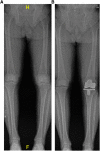Alignment options and robotics in total knee arthroplasty
- PMID: 36843989
- PMCID: PMC9947398
- DOI: 10.3389/fsurg.2023.1106608
Alignment options and robotics in total knee arthroplasty
Abstract
Total knee arthroplasty is one of the most widely performed surgical procedures today. Its widespread popularity has helped drive innovation and improvement in the field. Different schools of thought have developed regarding the best way to perform this operation. Specifically, there are controversaries regarding the best alignment philosophy for the femoral and tibial components to optimize implant stability and longevity. Traditionally, neutral mechanical alignment has been the preferred alignment target. More recently, some surgeons advocate for alignment matching the patient's pre-arthritic anatomic alignment ("physiologic" varus or valgus), which has been described as kinematic alignment. Functional alignment is a hybrid technique that focuses on the coronal plane minimizing soft tissue releases. To date, there is no evidence demonstrating superiority of one method over another. There is growing popularity of robotic surgical techniques to improve accuracy of implant position and alignment. The choice of alignment philosophy is an important aspect of robotic assisted TKA surgery and has the potential to clarify the optimal alignment technique.
Keywords: alignment; functional; kinematic; mechanical; robotics; total knee arthoplasty.
© 2023 Aflatooni, Wininger, Park and Incavo.
Conflict of interest statement
The authors declare that the research was conducted in the absence of any commercial or financial relationships that could be construed as a potential conflict of interest.
Figures


Similar articles
-
Comparison of robot-assisted and conventional total knee arthroplasty: a controlled cadaver study using multiparameter quantitative three-dimensional CT assessment of alignment.Comput Aided Surg. 2012;17(2):86-95. doi: 10.3109/10929088.2012.654408. Comput Aided Surg. 2012. PMID: 22348661
-
Coronal Correction for Severe Deformity Using Robotic-Assisted Total Knee Arthroplasty.J Knee Surg. 2018 Jan;31(1):2-5. doi: 10.1055/s-0037-1608840. Epub 2017 Nov 27. J Knee Surg. 2018. PMID: 29179223
-
Component placement accuracy in two generations of handheld robotics-assisted knee arthroplasty.Arch Orthop Trauma Surg. 2021 Dec;141(12):2059-2067. doi: 10.1007/s00402-021-04040-6. Epub 2021 Jul 25. Arch Orthop Trauma Surg. 2021. PMID: 34304279 Review.
-
Joint line is restored in robotic-arm-assisted total knee arthroplasty performed with a tibia-based functional alignment.Arch Orthop Trauma Surg. 2021 Dec;141(12):2175-2184. doi: 10.1007/s00402-021-04039-z. Epub 2021 Jul 13. Arch Orthop Trauma Surg. 2021. PMID: 34255176
-
Why Kinematic Alignment Makes Little Sense in Valgus Osteoarthritis of the Knee: A Narrative Review.J Clin Med. 2024 Feb 25;13(5):1302. doi: 10.3390/jcm13051302. J Clin Med. 2024. PMID: 38592153 Free PMC article. Review.
Cited by
-
Kinematic Alignment Does Not Result in Clinically Important Improvements After TKA Compared With Mechanical Alignment: A Meta-analysis of Randomized Trials.Clin Orthop Relat Res. 2025 Jun 1;483(6):1020-1030. doi: 10.1097/CORR.0000000000003356. Epub 2025 Jan 21. Clin Orthop Relat Res. 2025. PMID: 39842026
-
Editorial: Modern advances in arthroplasty.Front Surg. 2025 Feb 26;12:1568587. doi: 10.3389/fsurg.2025.1568587. eCollection 2025. Front Surg. 2025. PMID: 40078699 Free PMC article. No abstract available.
-
Navigating the Divide: A Comprehensive Review of the Mechanical and Anatomical Axis Approaches in Total Knee Replacement.Cureus. 2024 Apr 9;16(4):e57938. doi: 10.7759/cureus.57938. eCollection 2024 Apr. Cureus. 2024. PMID: 38738158 Free PMC article. Review.
-
Evaluation of the External Rotation of the Femur Component in Functionally Aligned Robotic-Assisted Total Knee Arthroplasty.Cureus. 2024 Jun 23;16(6):e62948. doi: 10.7759/cureus.62948. eCollection 2024 Jun. Cureus. 2024. PMID: 39044881 Free PMC article.
-
Implant placement parameters are associated with post operative dynamic varus and valgus knee angle in robotic assisted TKA.Sci Rep. 2025 Apr 16;15(1):13143. doi: 10.1038/s41598-025-98057-1. Sci Rep. 2025. PMID: 40240515 Free PMC article.
References
Publication types
LinkOut - more resources
Full Text Sources

